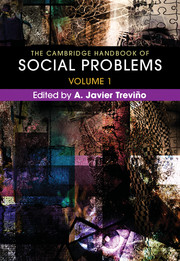Book contents
- The Cambridge Handbook of Social Problems
- The Cambridge Handbook of Social Problems
- Copyright page
- Contents
- About the Contributors
- Introduction
- Part I General Concerns and Orientations in the Study of Social Problems
- Part II Historical and Theoretical Issues in the Study of Social Problems
- Part III Problems of Discrimination and Inequality
- Part IV Problems of Institutions
- Chapter 26 Media and the Construction of Social Problems
- Chapter 27 Family Problems
- Chapter 28 Problems in Education
- Chapter 29 Problems of the Workplace and Workforce
- Chapter 30 Long-Term Unemployment in the United States
- Index
- References
Chapter 30 - Long-Term Unemployment in the United States
from Part IV - Problems of Institutions
Published online by Cambridge University Press: 16 March 2018
- The Cambridge Handbook of Social Problems
- The Cambridge Handbook of Social Problems
- Copyright page
- Contents
- About the Contributors
- Introduction
- Part I General Concerns and Orientations in the Study of Social Problems
- Part II Historical and Theoretical Issues in the Study of Social Problems
- Part III Problems of Discrimination and Inequality
- Part IV Problems of Institutions
- Chapter 26 Media and the Construction of Social Problems
- Chapter 27 Family Problems
- Chapter 28 Problems in Education
- Chapter 29 Problems of the Workplace and Workforce
- Chapter 30 Long-Term Unemployment in the United States
- Index
- References
Summary
As of 2015, the percentage of the unemployed who are long-term unemployed remains at levels unseen in the US in over six decades. A well-established literature associates long-term unemployment with a variety of social ills, including poverty, increased risk of physical and mental health problems, and deteriorating emotional well-being. This chapter describes the nature and scope of long-term unemployment in the United States and its impact on individuals and families. It also focuses on the issue of mental health and explores the causal relationship between long-term unemployment and mental health as well as the most promising solutions to the mental health challenges raised by long-term unemployment. The final section of the chapter focuses on the challenges that arise when long-term unemployed workers internalize the stigma of unemployment and blame themselves for their labor market difficulties, and it considers possible causes of and solutions to such self-blame.
- Type
- Chapter
- Information
- The Cambridge Handbook of Social Problems , pp. 551 - 566Publisher: Cambridge University PressPrint publication year: 2018
References
- 8
- Cited by



